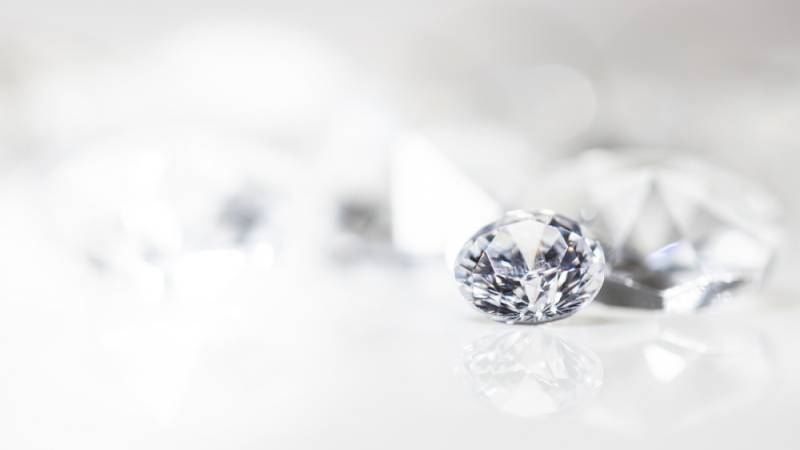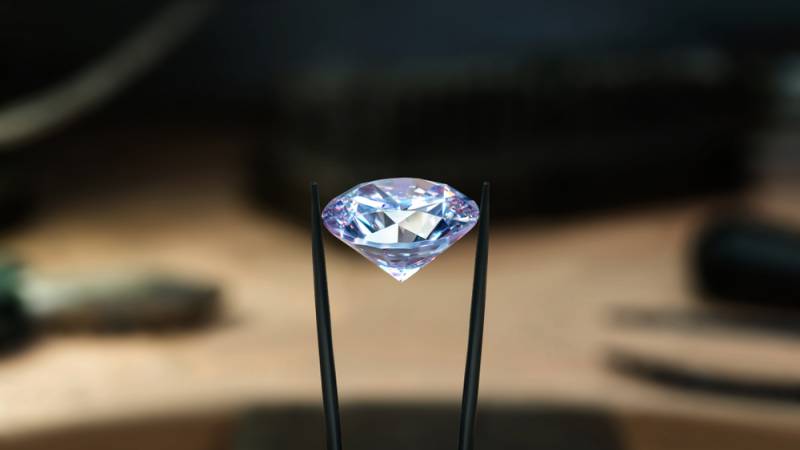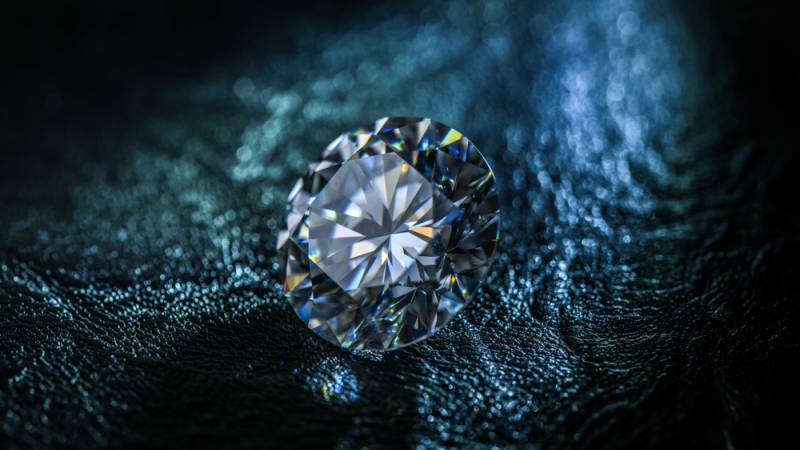As you are aware, the cut of a diamond plays a crucial role in determining its price. Alongside other factors, experts carefully consider the stone’s proportions to assess the quality of its cut.
Although diamond proportions may seem like a complex combination of numbers and percentages, disregarding them can result in a diamond lacking brilliance.
So, why is diamond proportion so important?
Understanding how to interpret these numbers gives you a kind of superpower – the ability to assess the presence and degree of brilliance in diamonds. In simpler terms, diamond proportion factors help you determine whether a stone has an excellent cut or not.
Moreover, this knowledge empowers you to form your own judgment regarding the value of a diamond. Let’s delve into how to read diamond proportion percentages and make the most of this knowledge!
DESIGN YOUR OWN ENGAGEMENT RING: START WITH A SETTING OR START WITH A DIAMOND. IT’S REALLY UP TO YOU!

What Exactly Is Diamond Proportion?
Diamond proportions are essentially measurements of angles and lengths within a diamond. These measurements are not random but rather specify the diameter of the gem and the depth and width of its different sections, such as the crown, table size, pavilion angle, and height.
These dimensions are commonly expressed in millimeters or percentages.
The anatomy and geometry of diamonds are determined by various ratios. Therefore, a diamond with ideal length, breadth, and depth ratios for its shape and carat weight will have a superb cut and excellent visual appeal.
Moreover, diamond proportions play a significant role in the diamond’s ability to effectively reflect light. This is achieved through the captivating play of light within the gem, involving colored and white light and alternating flashes, all facilitated by precisely cut angles and lengths.
These proportions directly impact the diamond’s fire, brightness, and scintillation, making them primary factors in defining cut excellence and determining diamond pricing.
To calculate diamond proportions, specific percentage values need to be obtained, primarily focusing on the pavilion depth, table size, and crown height in relation to the diameter of the stone. Including size in these calculations is crucial because diamonds vary in shape and carat weight, and considering size improves the accuracy of the derived values.
Even the slightest alteration in any of the diamond proportions can negatively affect the delicate brilliance of the precious stone. This is because cut quality is closely tied to the diamond’s ability to allow light to flow through its surface and back into the viewer’s eye. Any disruption in this interaction diminishes the process of light reflection, resulting in a dull and less vibrant appearance.
Let’s now discuss two important aspects of diamond proportion: the diamond table and depth.
The diamond table refers to the top surface of the jewel, the largest facet visible when viewing the stone from above. When comparing different diamonds, you’ll notice that they all share this flat, table-like surface.
To calculate the table dimensions, divide the table width by the total stone diameter, which represents the widest width of a fancy-shaped diamond.
For example, if the lengths are 3 mm and 4 mm, the table size would be 75%. However, it’s important to note that this interpretation is oversimplified. Light can get lost within a diamond and unpredictably bounce off the sides, never reaching the table. Even if the width and depth requirements are met, the cut may still be poor.
On the other hand, if the table width is 2 mm and the gem diameter is 3 mm, the table value would be 66%. This is already excessive, and regardless of perfect width and depth, the stone would not reflect light well, resulting in poor cut quality and a lifeless appearance.
Therefore, the diamond table size is a crucial aspect of the diamond’s overall appearance. The table percentage ratios provided for popular diamond shapes should be used as general guidelines, as diamonds are more complex than a few digits.
Another important factor is the diamond depth, which is calculated by dividing the height of the stone by its width. The height refers to the length of the gem from top to bottom at its base. For example, if a diamond has a depth of 4 mm and a width of 5 mm, the depth percentage would be 80%.
A diamond with a lower depth percentage may appear larger due to its greater width but often lacks brilliance as it doesn’t reflect light effectively. The light passes through the stone without leaving a noticeable mark, resulting in a lack of sparkle and brightness, indicating poor cut quality. Conversely, a diamond with a higher depth percentage leaks light from the bottom, giving it a lifeless appearance.
All these factors, including depth, table, and width, collectively determine how well a diamond refracts and reflects light. Thus, it is crucial to find a diamond with optimal cut ratios in each section.
Apart from width, depth, and table width, other factors such as shape, size, cut, and facet angles also influence how effectively a diamond interacts with light.
To determine whether a diamond has an appropriate cut, evaluating these characteristics is important. For round-cut diamonds, the ideal diamond proportions are as follows:
- Table Percentage: 54 – 57%
- Depth Percentage: 59 – 62.6%
- Length to Width Ratio: 1.0 – 1.03
- Girdle Thickness: Thin to Slightly Thin
Adhering to these perfect diamond proportions will help you choose a magnificent gemstone that maximizes light absorption and reflection. Begin your search among GIA and AGS Excellent and Ideal cut diamonds, keeping in mind that some diamonds labeled as “Excellent” or “Ideal” may still fall outside these parameters.

The Origin Of The Ideal Cut
In 1919, Marcel Tolkowsky, a Belgian engineering graduate from a diamond-cutting family, introduced the concept of desirable diamond proportions in his book “Diamond Design.” His research focused on the dimensions of round brilliant cut diamonds, aiming to maximize their fire and brightness based on the physics of light. While scintillation received less attention in his thesis, it is worth noting that American cutters, such as Henry Morse, had been cutting diamonds to similar standards before Tolkowsky’s research was published.
When the American Gem Society’s lab (AGSL) specialized in cut excellence debuted in 1996, they adopted Tolkowsky’s dimensions as the foundation for their Ideal Cut classification.
According to Tolkowsky’s specifications for the ideal cut, a round brilliant diamond should have 25 pavilion facets and 33 crown facets for optimal light reflection. He also specified the following angles and depths:
- Total Depth: 59.3%
- Diameter: 53%
- Crown Angle: 34.5 degrees
- Pavilion Angle: 40.75 degrees
- Pavilion Depth: 43.1%
However, grading laboratories today are less strict with diamond percentage values, resulting in a broader range of numbers for the perfect cut. For example, the optimal diamond depth for a round brilliant cut can range from 59.3% to 62.6%, allowing diamond cutters more flexibility.
The crown angle, which refers to the angle between the table and the girdle of the diamond, significantly affects a diamond’s frontal appearance and fire. Calculating the crown angle involves dividing the table by 100, subtracting the result from 1, multiplying by 50, dividing the crown depth by the previous answer, and using the inverse tangent function (Tan – 1) on a scientific calculator to obtain the crown angle in degrees.
The pavilion angle, another crucial factor, contributes to a diamond’s sparkle and prismatic light. The pavilion angle can be determined by dividing the pavilion depth by 50 and using the inverse tangent function on a calculator to find the pavilion angle in degrees.
Achieving the perfect balance between crown and pavilion angles is essential for excellent light performance in a diamond. Even minor alterations in these angles can significantly impact a diamond’s brilliance, fire, and sparkle. Generally, a pavilion angle between 40.6° and 41.0° produces the highest brightness, and compensating for slightly shallow or steep pavilion angles can be done with an appropriate crown angle. For example, a shallow pavilion angle of 40.5° can be offset by a higher crown angle of 35°, while a steep pavilion angle of 41° can be adjusted with a crown angle of 34°.
By considering these factors, one can select a diamond that exhibits exceptional light performance.

Conclusion
In conclusion, diamond proportion is a critical aspect that should not be overlooked when selecting a gemstone. It goes beyond mere numbers and percentages and plays a significant role in the stone’s overall shine. While color and clarity are often considered important, disregarding proportion can be risky.
It is advisable to choose a diamond that falls within the recommended proportions discussed in this article. While slight deviations may not pose a problem, the closer a diamond is to these ideal dimensions, the better its light performance will be.


